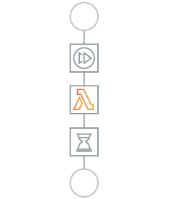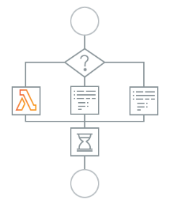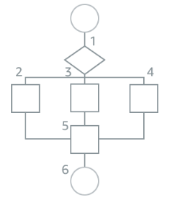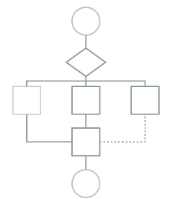Step Functions Getting Started
AWS Step Functions is a visual workflow service that makes it easy to orchestrate over 220 AWS services and HTTPS endpoints such as SaaS applications into scalable, reliable, and resilient application. It supports common architectural and workflow patterns which makes it easy to coordinate the components of distributed applications as a series of durable steps in a visual workflow. Step Functions' workflows are written using Amazon States Language (ASL), defined as state machines, composed of steps called state, and can be used to orchestrate multiple AWS services.
Step Functions gives developers the ability to build and update applications quickly by managing the logic and implementing branching, parallel execution, and timeouts. Step Functions can also manage state, checkpoints, and restarts for you to make sure your application executes in order and as expected. It has built-in try/catch, retry, and rollback capabilities to help you deal with errors and exceptions automatically.
If you have a workload that requires co-ordinating distinct tasks, aggregation of results, fan-in and fan-out patterns, or that require human intervention, you may consider using Step Functions.
Common use cases include large-scale data processing, orchestration of microservices to build event-driven architectures, create data and machine learning pipelines, integration with SaaS applications, build generative AI applications, and automate IT security and processes.
No matter whether you are new to Step Functions or you already have a use case in mind, choose your own path and follow the curated learning steps to get started on Step Functions for a few of the common use cases.
AWS Step Functions Learning Paths
Core concepts of serverless workflows
What are the core concepts of serverless workflows that you might encounter when working with Step Functions?
Below we will go over some of the most important concepts, and their definitions such as: pass states, parallel states, choice states, state transitions, component reusability, and branching logic.
Once you've gone through the main concepts, you will be ready to create your first Step Functions State Machine.
AWS Step Functions lets you coordinate individual tasks into a visual workflow, so you can build and update apps quickly.

The workflows you build with Step Functions are called state machines, and each step of your workflow is called a state.

Tasks perform work, either by coordinating another AWS service or an application that you can host basically anywhere.

Pass states pass their input as output to the next state. You can also delay execution when you need to using wait states.

Parallel states begin multiple branches of execution at the same time, such as running multiple Lambda functions at once.

Choice states add branching logic to your state machine, and make decisions based on their input.

When you execute your state machine, each move from one state to the next is called a state transition.

You can reuse components, easily edit the sequence of steps or swap out the code called by task states as your needs change.

That's it! You're now familiar with the core concepts of Step Functions. Why not create your first state machine?
